3D X-ray Micro-CT Analysis of Rebar Corrosion in Reinforced Concrete Subjected to a Chloride-Induced Environment
Abstract
:1. Introduction
2. Significance of the Research
- Detailed and thorough 3D experimental measurements and analyses of reinforcement loss due to corrosion and its influence on concrete microstructure using X-ray micro-computed tomography
- 3D X-ray micro-computed 3D investigations of fractures in reinforced concrete samples subjected to pull-out tests.
3. Sample Preparation
4. Initial X-ray Micro-CT Scanning
5. Corrosion Test
6. Pull-Out Test
7. Discussion
8. Conclusions
- X-ray micro-CT allows visualization of material micro-structure, steel rebar with ribs, and air void distribution. Thus, the measured total air volume in the non-cracked reinforced concrete specimens ranged from 2.75% to 2.81%, whereas closed porosity varied from 2.39% to 2.49% and open porosity varied from 0.55% to 0.61%, respectively.
- X-ray micro-CT scanning enables observation of the evolution of corrosion outside and inside the concrete sample after 14, 42, and 70 days. After 14 days of the chloride-accelerated corrosion test, noticeable corrosion changes within the rebar were noticed. Corrosion development is mainly visible in the rebar area outside the concrete cube. After 42 days of the chloride-acceleration experiment, corrosion of the rebar outside the concrete visibly increased while the corrosion within the concrete interior just slightly evolved. Similar conclusions might be drawn after 70 days of the experiment.
9. Future Perspectives
Author Contributions
Funding
Informed Consent Statement
Data Availability Statement
Conflicts of Interest
Sample Availability
References
- Koch, G.; Varney, J.; Thompson, N. International Measures of Prevention, Application, and Economics of Corrosion Technologies Study; NACE International: Houston, TX, USA, 2016. [Google Scholar]
- Hou, B.; Li, X.; Ma, X.; Du, C.; Zhang, D.; Zheng, M.; Xu, W.; Lu, D.; Ma, F. The cost of corrosion in China. npj Mater. Degrad. 2017, 1, 4. [Google Scholar] [CrossRef]
- Ožbolt, J.; Balabanić, G.; Periškić, G.; Kušter, M. Modelling the effect of damage on transport processes in concrete. Constr. Build. Mater. 2010, 24, 1638–1648. [Google Scholar] [CrossRef]
- Apostolopoulos, C.; Demis, S.; Papadakis, V. Chloride-infused corrosion of steel reinforcement. Mechanical performance and pit depth analysis. Constr. Build. Mater. 2013, 38, 139–146. [Google Scholar] [CrossRef]
- Šavija, B.; Luković, M.; Hosseini, S.A.S.; Pacheco, J.; Schlangen, E. Corrosion induced cover cracking studied by X-ray computed tomography, nanoindentation, and energy dispersive X-ray spectrometry (EDS). Mater. Struct. 2015, 48, 2043–2062. [Google Scholar] [CrossRef]
- Cheng, Y.; Hanif, A.; Chen, E.; Ma, G.; Li, Z. Simulation of a novel capacitive sensor for rebar corrosion detection. Constr. Build. Mater. 2018, 174, 613–624. [Google Scholar] [CrossRef]
- Shi, J.; Ming, J.; Zhang, Y.; Jiang, J. Corrosion products and corrosion-induced cracks of low-alloy steel and low-carbon steel in concrete. Cem. Concr. Compos. 2018, 88, 121–129. [Google Scholar] [CrossRef]
- Van Steen, C.; Pahlavan, L.; Wevers, M.; Verstrynge, E. Localisation and characterisation of corrosion damage in reinforced concrete by means of acoustic emission and X-ray computed tomography. Constr. Build. Mater. 2019, 197, 21–29. [Google Scholar] [CrossRef]
- Xi, X.; Yang, S. Investigating the spatial development of corrosion of corner-located steel bar in concrete by X-ray computed tomography. Constr. Build. Mater. 2019, 221, 177–189. [Google Scholar] [CrossRef]
- Wang, P.; Qiao, H.; Zhang, Y.; Li, Y.; Chen, K.; Feng, Q. Three-dimensional characteristics of steel corrosion and corrosion-induced cracks in magnesium oxychloride cement concrete monitored by X-ray Computed Tomography. Constr. Build. Mater. 2020, 246, 118504. [Google Scholar] [CrossRef]
- Filho, F.M.; Copuroglu, O.; Schlangen, E.; Šavija, B. Determination of Loss of Reinforcement due to Corrosion through X-ray Computer Micro-Tomography. Materials 2021, 14, 893. [Google Scholar] [CrossRef]
- Li, M.; Yao, L.; He, L.; Mao, X.; Li, G. Experimental study on the compressive behavior of concrete filled steel tubular columns with regional corrosion. Structures 2022, 35, 882–892. [Google Scholar] [CrossRef]
- Zhang, X.; Zhang, Y.; Liu, B.; Liu, B.; Wu, W.; Yang, C. Corrosion-indused spalling of concrete cover and its effects on shear strength of RC beams. Eng. Fail. Anal. 2021, 127, 105538. [Google Scholar] [CrossRef]
- Xu, W.; Li, Y.; Li, H.; Wang, K.; Zhang, C.; Jiang, Y.; Qiang, S. Corrosion mechanism and damage characteristic of steel fiber concrete under the effect of stray current and salt solution. Constr. Build. Mater. 2022, 314, 125618. [Google Scholar] [CrossRef]
- EN 12350-7:2009; Testing fresh concrete. Air content. Pressure methods.
- EN 12390-3:2009; Testing hardened concrete—Part 3: Compressive strength of test specimens.
- EN 12390-6:2011; Testing hardened concrete—Part 6: Tensile splitting strength of test specimens.
- EN 14651:2005+A1:2007; Test method for metallic fiber concrete. Measuring the flexural tensile strength (limit of proportionality (LOP), residual).
- Vicente, M.A.; Ruiz, G.; Gonzalez, D.C.; Minguez, J.; Tarifa, M.; Zhang, X.X. CT-Scan study of crack patterns of fiber-reinforced concrete loaded monotonically and under low-cycle fatigue. Int. J. Fatigue 2018, 114, 138–147. [Google Scholar] [CrossRef]
- Chung, S.-Y.; Elrahman, M.A.; Stephan, D.; Kamm, P.H. The influence of different concrete additions on the properties of lightweight concrete evaluated using experimental and numerical approaches. Constr. Build. Mater. 2018, 189, 314–322. [Google Scholar] [CrossRef]
- Schock, J.; Liebl, S.; Achterhold, K.; Pfeiffer, F. Obtaining the spacing factor of microporous concrete using high-resolution Dual Energy X-ray Micro CT. Cem. Concr. Res. 2016, 89, 200–205. [Google Scholar] [CrossRef]
- Liu, T.; Qin, S.; Zou, D.; Song, W.; Teng, J. Mesoscopic modeling method of concrete based on statistical analysis of CT images. Constr. Build. Mater. 2018, 192, 429–441. [Google Scholar] [CrossRef]
- Loefflera, C.M.; Qiua, Y.; Martin, B.; Heard, W.; Williams, B.; Niea, X. Detection and segmentation of mechanical damage in concrete with X-ray microtomography. Mater. Charact. 2018, 142, 515–522. [Google Scholar] [CrossRef]
- Nguyen, T.T.; Bui, H.H.; Ngo, T.D.; Nguyen, G.D. Experimental and numerical investigation of influence of air-voids on the compressive behaviour of foamed concrete. Mater. Des. 2017, 130, 103–119. [Google Scholar] [CrossRef]
- Dorys, C.; González, J.M.; Vicente, M.A.; Cambronero, F.; Aragón, G. Study of the effect of the fibers’ orientation on the post-cracking behavior of steel fiber reinforced concrete from wedge-splitting tests and computed tomography scanning. Constr. Build. Mater. 2018, 192, 110–122. [Google Scholar]
- Ponikiewski, T.; Katzer, J.; Bugdol, M.; Rudzki, M. Determination of 3D porosity in steel fibre reinforced SCC beams using X-ray computed tomography. Constr. Build. Mater. 2014, 68, 333–340. [Google Scholar] [CrossRef]
- Skarżyński, Ł.; Tejchman, J. Experimental investigations of fracture process using DIC in plain and reinforced concrete beams under bending. Strain 2013, 49, 521–543. [Google Scholar] [CrossRef]
- Suchorzewski, J.; Tejchman, J.; Nitka, M. Experimental and numerical investigations of concrete behaviour at meso-level during quasi-static splitting tension. Theor. Appl. Fract. Mech. 2018, 96, 720–739. [Google Scholar] [CrossRef]
- Suchorzewski, J.; Tejchman, J.; Nitka, M. DEM simulations of fracture in concrete under uniaxial compression based on its real internal structure. Int. J. Damage Biomech. 2018, 27, 578–607. [Google Scholar] [CrossRef]
- Skarżynski, Ł.; Marzec, I.; Tejchman, J. Crack evolution in concrete compressive fatigue experiments based on X-ray micro-CT images. Int. J. Fatigue 2018, 122, 256–272. [Google Scholar] [CrossRef]
- Skarżyński, Ł.; Tejchman, J. Experimental Investigations of Fracture Process in Concrete by Means of X-ray Micro-computed Tomography. Strain 2015, 52, 26–45. [Google Scholar] [CrossRef]
- Skarżyński, Ł.; Suchorzewski, J. Mechanical and fracture properties of concrete reinforced with recycled and industrial steel fibers using Digital Image Correlation technique and X-ray micro computed tomography. Constr. Build. Mater. 2018, 183, 283–299. [Google Scholar] [CrossRef]
- Skarżyński, Ł. Mechanical and radiation shielding properties of concrete reinforced with boron-basalt fibers using Digital Image Correlation and X-ray micro-computed tomography. Constr. Build. Mater. 2020, 255, 119252. [Google Scholar] [CrossRef]


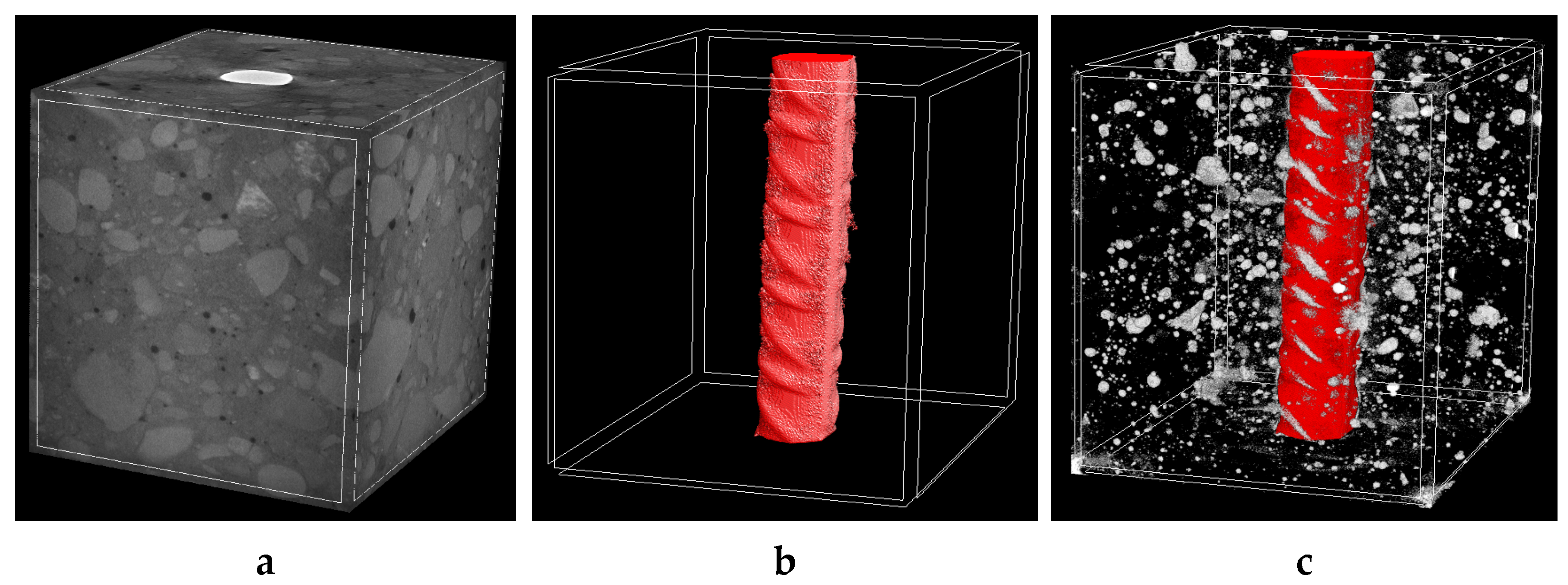

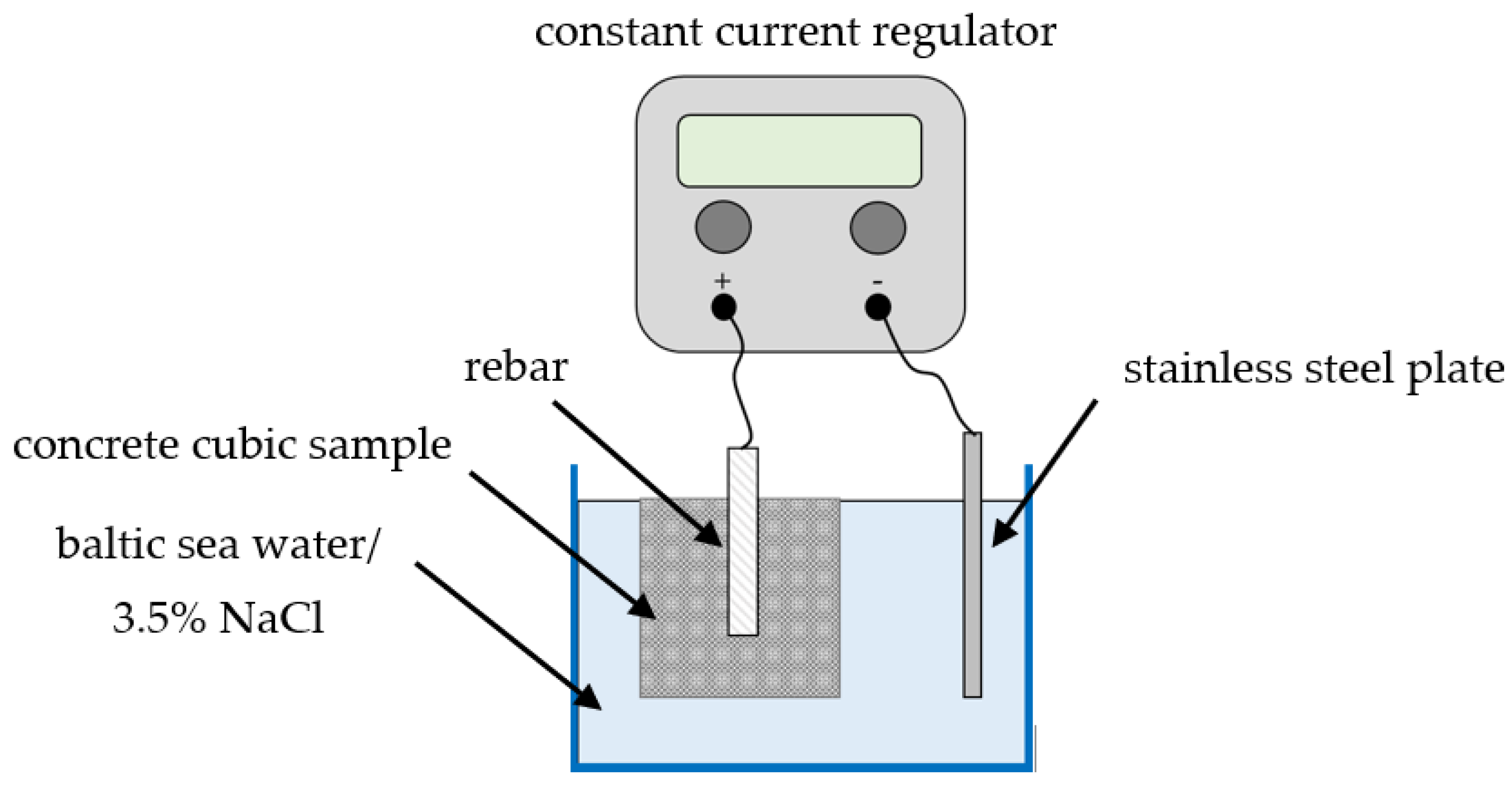
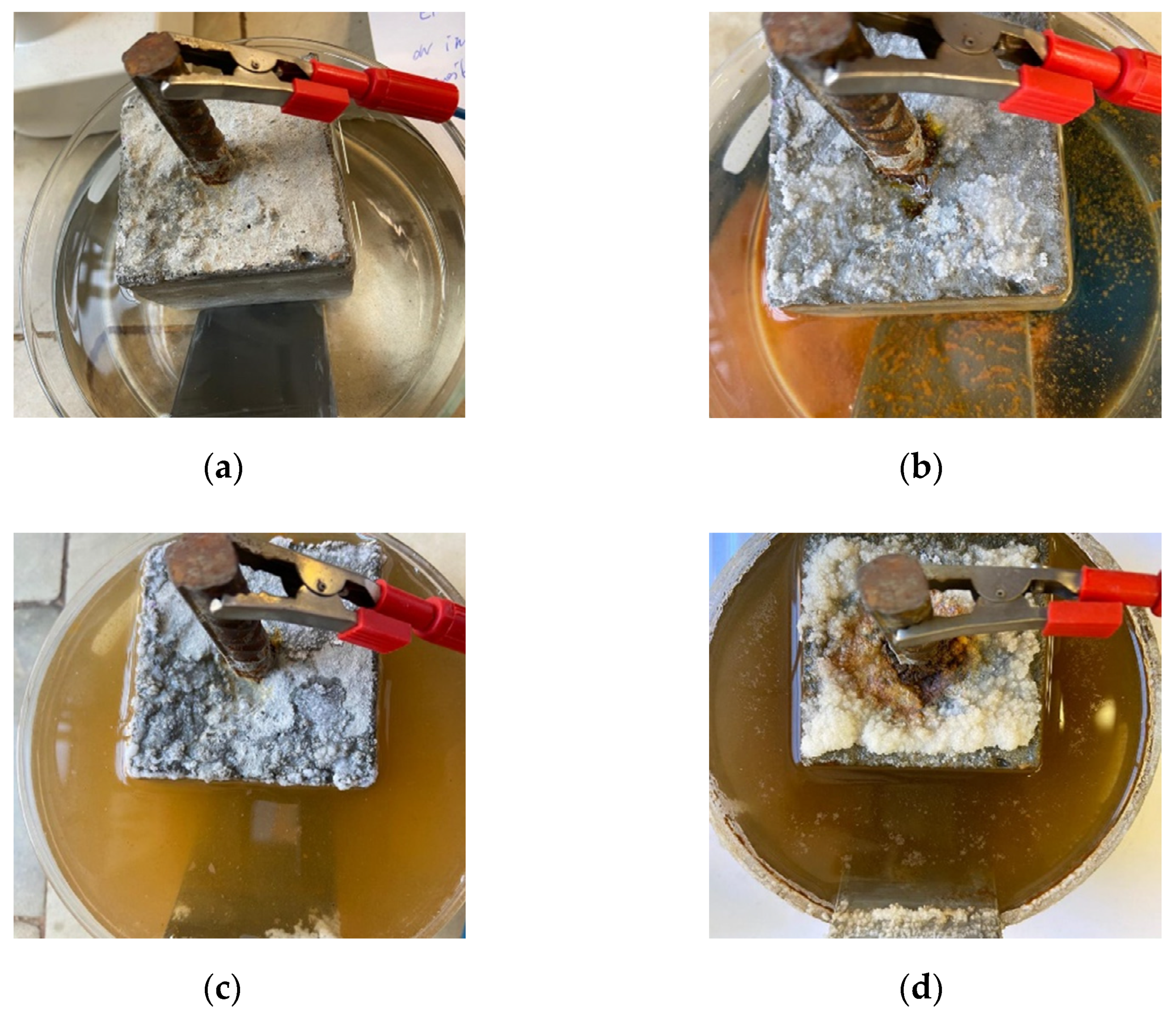

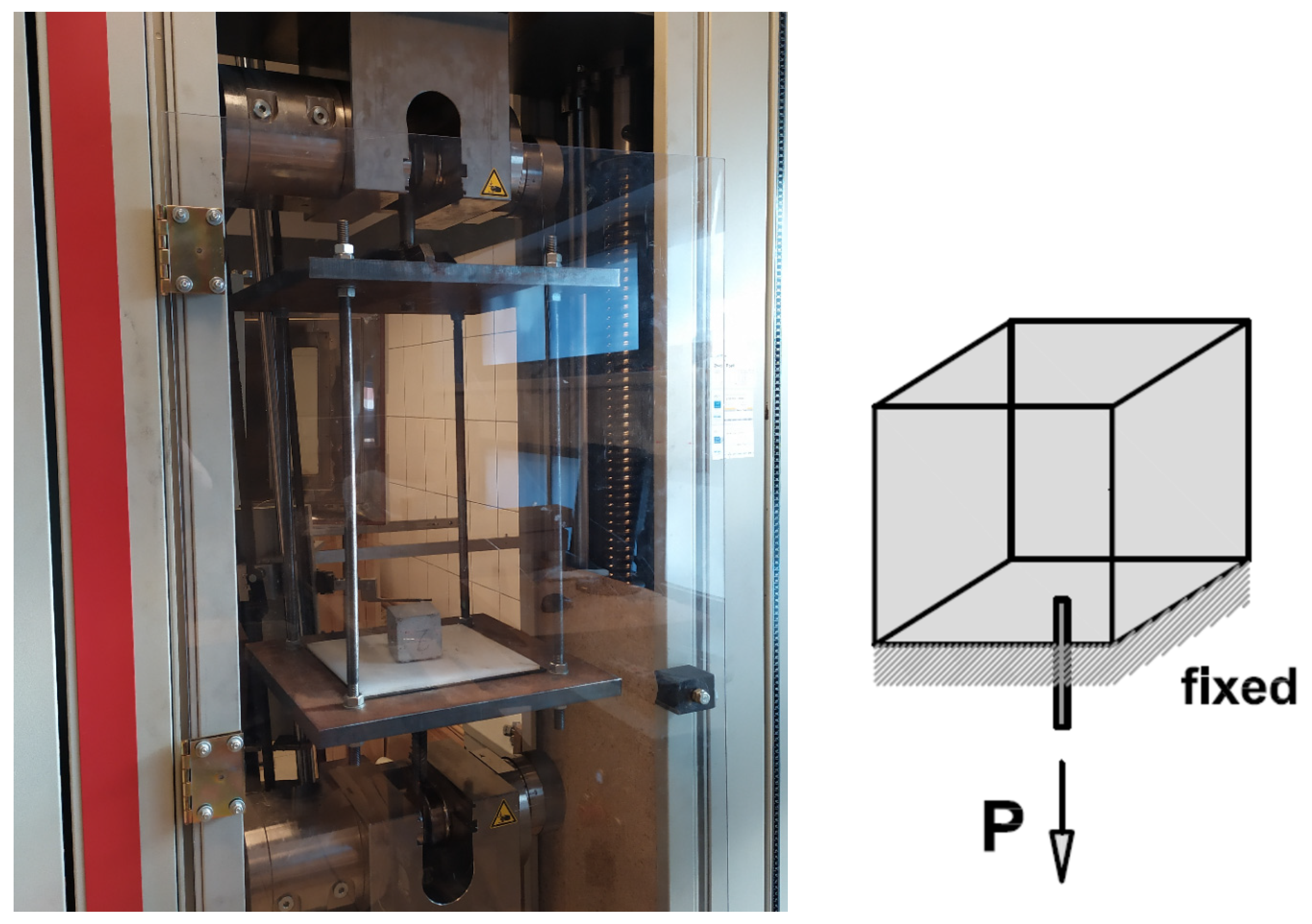

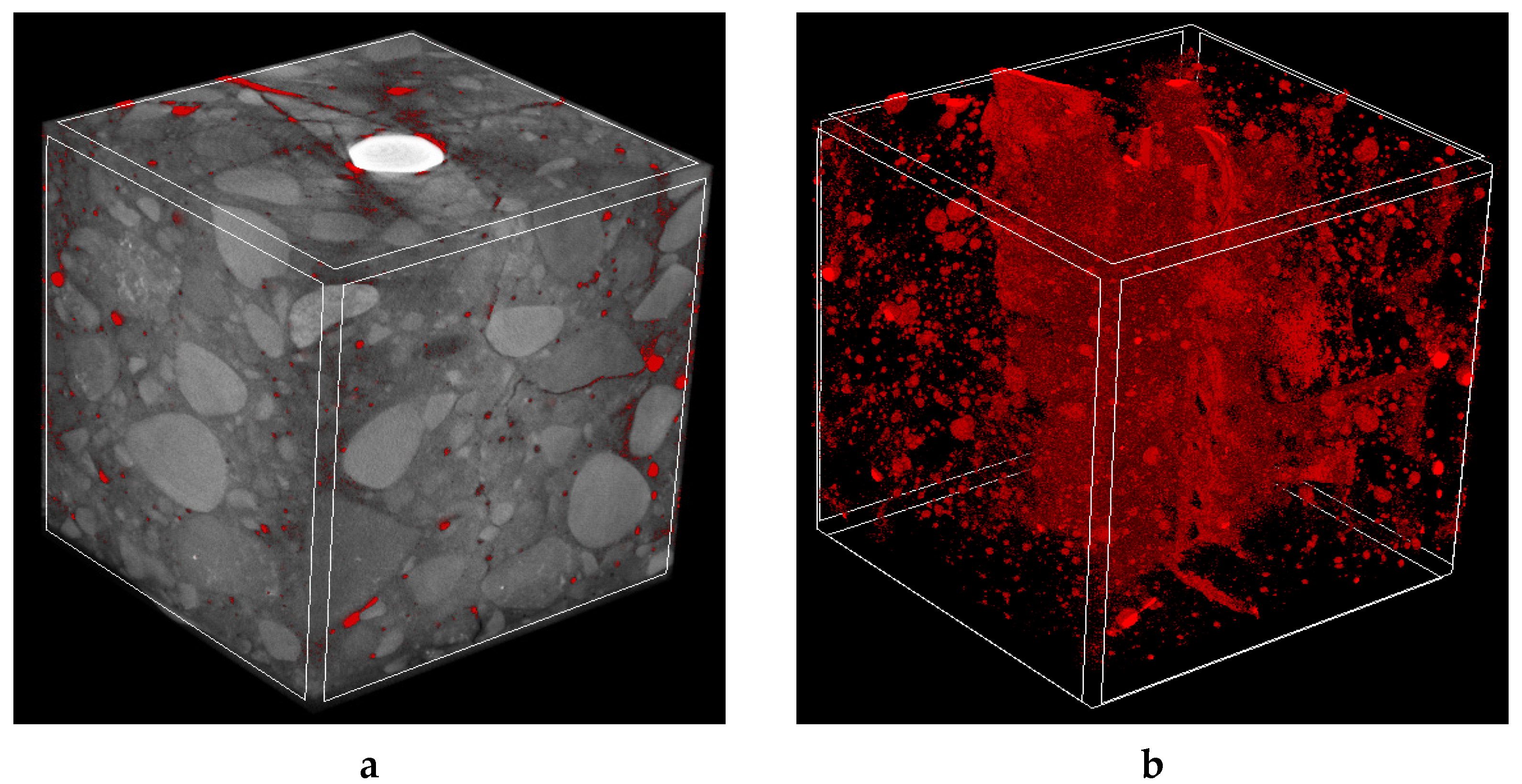

| Concrete Components | Concrete Mix (d50 = 2 mm, dmax = 16 mm) |
|---|---|
| Cement CEM II/A-LL 42.5 R | 300 kg/m3 |
| Sand (0–2 mm) | 735 kg/m3 |
| Gravel aggregate (2–8 mm) | 430 kg/m3 |
| Gravel aggregate (8–16 mm) | 665 kg/m3 |
| Superplasticizer | 1.8 kg/m3 |
| Water | 150 kg/m3 |
| Concrete Mix | Temperature [°C] | Vebe SLUMP Test [mm] | Vebe Time [s] | Air Content [%] |
|---|---|---|---|---|
| Plain concrete mix (Table 1) | 15.2 | 140 | 3.2 | 2.86 |
Publisher’s Note: MDPI stays neutral with regard to jurisdictional claims in published maps and institutional affiliations. |
© 2021 by the authors. Licensee MDPI, Basel, Switzerland. This article is an open access article distributed under the terms and conditions of the Creative Commons Attribution (CC BY) license (https://creativecommons.org/licenses/by/4.0/).
Share and Cite
Skarżyński, Ł.; Kibort, K.; Małachowska, A. 3D X-ray Micro-CT Analysis of Rebar Corrosion in Reinforced Concrete Subjected to a Chloride-Induced Environment. Molecules 2022, 27, 192. https://doi.org/10.3390/molecules27010192
Skarżyński Ł, Kibort K, Małachowska A. 3D X-ray Micro-CT Analysis of Rebar Corrosion in Reinforced Concrete Subjected to a Chloride-Induced Environment. Molecules. 2022; 27(1):192. https://doi.org/10.3390/molecules27010192
Chicago/Turabian StyleSkarżyński, Łukasz, Katarzyna Kibort, and Aleksandra Małachowska. 2022. "3D X-ray Micro-CT Analysis of Rebar Corrosion in Reinforced Concrete Subjected to a Chloride-Induced Environment" Molecules 27, no. 1: 192. https://doi.org/10.3390/molecules27010192






